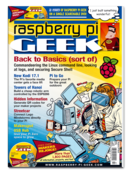Create a call button for a family member in need
When someone in your household becomes ill or incapacitated, you can see to their needs and help them feel less isolated – without completely upsetting your routine – by creating a call button that lets you know when the unfortunate one needs help. In this article, I show you how to build wireless- and cloud-based call systems with littleBits [1], then I rig up a retro servant's call box just for fun.
Simple Wireless
The simplest setup comprises a button and wireless transmitter on one end and a wireless receiver and buzzer on the other end (Figure 1). The wireless boards can be powered by 9V batteries, so as the ailing user becomes ambulatory, they can still ask for assistance.
[...]
Use Express-Checkout link below to read the full article (PDF).
Buy this article as PDF
Express-Checkout as PDF
Pages: 4
Price $2.95
(incl. VAT)
(incl. VAT)








